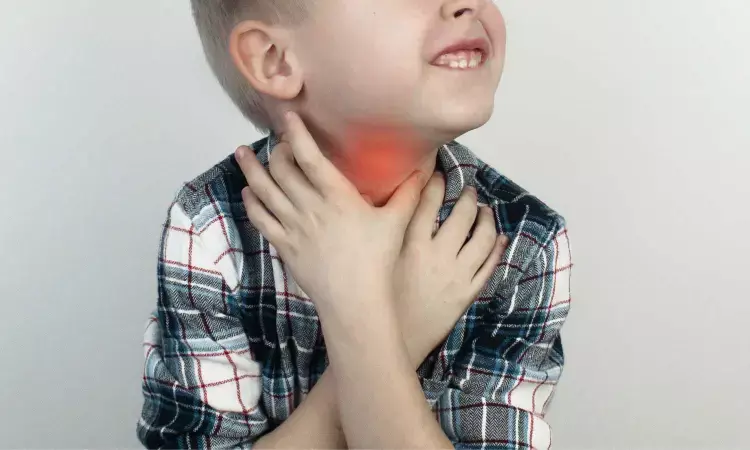- Home
- Medical news & Guidelines
- Anesthesiology
- Cardiology and CTVS
- Critical Care
- Dentistry
- Dermatology
- Diabetes and Endocrinology
- ENT
- Gastroenterology
- Medicine
- Nephrology
- Neurology
- Obstretics-Gynaecology
- Oncology
- Ophthalmology
- Orthopaedics
- Pediatrics-Neonatology
- Psychiatry
- Pulmonology
- Radiology
- Surgery
- Urology
- Laboratory Medicine
- Diet
- Nursing
- Paramedical
- Physiotherapy
- Health news
- Fact Check
- Bone Health Fact Check
- Brain Health Fact Check
- Cancer Related Fact Check
- Child Care Fact Check
- Dental and oral health fact check
- Diabetes and metabolic health fact check
- Diet and Nutrition Fact Check
- Eye and ENT Care Fact Check
- Fitness fact check
- Gut health fact check
- Heart health fact check
- Kidney health fact check
- Medical education fact check
- Men's health fact check
- Respiratory fact check
- Skin and hair care fact check
- Vaccine and Immunization fact check
- Women's health fact check
- AYUSH
- State News
- Andaman and Nicobar Islands
- Andhra Pradesh
- Arunachal Pradesh
- Assam
- Bihar
- Chandigarh
- Chattisgarh
- Dadra and Nagar Haveli
- Daman and Diu
- Delhi
- Goa
- Gujarat
- Haryana
- Himachal Pradesh
- Jammu & Kashmir
- Jharkhand
- Karnataka
- Kerala
- Ladakh
- Lakshadweep
- Madhya Pradesh
- Maharashtra
- Manipur
- Meghalaya
- Mizoram
- Nagaland
- Odisha
- Puducherry
- Punjab
- Rajasthan
- Sikkim
- Tamil Nadu
- Telangana
- Tripura
- Uttar Pradesh
- Uttrakhand
- West Bengal
- Medical Education
- Industry
New probability tool could help reduce bleeding rates in children undergoing tonsillectomy

USA: UT Southwestern researchers have developed a probability model for post-tonsillectomy bleeding rates, which surgeons and future research groups can use to compare patients, subpopulations, and institutions.
The findings of the retrospective cohort study, published in JAMA Otolaryngology–Head & Neck Surgery, provided estimated bleeding rates to guide surgeons in self-monitoring their frequency and improving quality outcomes for pediatric patients following tonsillectomy.
This study involving 96 415 children who underwent tonsillectomy found that the predicted 5th, 50th, and 95th quantiles for bleeding after a tonsillectomy procedure were 1.17%, 1.97%, and 4.75%, respectively.
An updated guideline issued in 2019 by the American Academy of Otolaryngology-Head and Neck Surgery Foundation for pediatric tonsillectomies recommended that surgeons self-monitor the bleeding rates of their patients after these procedures. The lead author on those guidelines was Ron Mitchell, University of Texas Southwestern Medical Center at Dallas, also the current study's lead author.
Complications after tonsillectomies are rare, but excessive bleeding is considered the most common factor in the very few deaths related to the surgery. The authors note that the change in guidelines is a significant step towards improving tonsillectomy safety, but a significant hurdle was their effective use. According to them, no standards existed to inform doctors whether their institutional or personal bleeding rates were considered low, normal, or high.
Against the above background, Romaine F. Johnson from the University of Texas Southwestern Medical Center at Dallas and colleagues aimed to estimate the probability of bleeding after pediatric tonsillectomy to guide surgeons in self-monitoring this event using a national cohort of children.
They collected data from the Pediatric Health Information System database of the Children's Hospital Association, which contains de-identified patient information covering outpatient surgeries, inpatient stays, observation unit patient data, and emergency department visits from more than 49 not-for-profit children's hospitals in the US.
The investigators were primarily focused on data comprising patients who came to the emergency department (ED) or were readmitted for bleeding following tonsillectomies, indicating that their bleeding after the procedure was considered excessive. They collected medical histories and demographic data on these patients.
The authors reported the following findings:
- Of the 96 415 children (mean age, 5.3 years; 42.8% female) who had undergone tonsillectomy, 2.18% returned to the ED or hospital with postoperative bleeding.
- The predicted 5th, 50th, and 95th quantiles for bleeding were 1.17%, 1.97%, and 4.75%, respectively.
- Variables associated with bleeding after tonsillectomy were Hispanic ethnicity (OR, 1.19), very high residential Opportunity Index (OR, 1.28), gastrointestinal disease (OR, 1.33), obstructive sleep apnea (OR, 0.85), obesity (OR,1.24), and being more than 12 years old (OR, 2.48).
- The adjusted 99th percentile for bleeding after tonsillectomy was approximately 6.39%.
"Our findings provide estimated bleeding rates to guide surgeons in self-monitoring their frequency and improving quality outcomes for pediatric patients after tonsillectomy," the research team concluded.
Reference:
Johnson RF, Beams DR, Zaniletti I, et al. Estimated Probability Distribution of Bleeding After Pediatric Tonsillectomy: A Retrospective National Cohort Study of US Children. JAMA Otolaryngol Head Neck Surg. Published online March 30, 2023. doi:10.1001/jamaoto.2023.0268
Dr Kamal Kant Kohli-MBBS, DTCD- a chest specialist with more than 30 years of practice and a flair for writing clinical articles, Dr Kamal Kant Kohli joined Medical Dialogues as a Chief Editor of Medical News. Besides writing articles, as an editor, he proofreads and verifies all the medical content published on Medical Dialogues including those coming from journals, studies,medical conferences,guidelines etc. Email: drkohli@medicaldialogues.in. Contact no. 011-43720751


